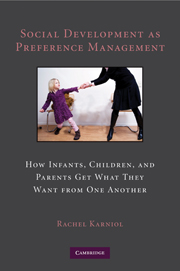 Social Development as Preference Management
Social Development as Preference Management Book contents
- Frontmatter
- Contents
- Acknowledgments
- Introduction
- 1 The Baby “Preference Game”
- 2 Children's Expression of Preferences
- 3 Emerging Meta-Preferences
- 4 Other People's Preferences
- 5 Parenting and Preference Management
- 6 Channeling Children's Preferences
- 7 Temporizing Preferences
- 8 Restricting Children's Preferences
- 9 Disciplining Noncompliance
- 10 Planes of Transformational Thought: Temporal, Imaginal, and Mental
- 11 Manipulating Others
- 12 Coping and Self-Regulating
- 13 Mind Play: Applying Transformational Thought
- 14 Minding One's Own Versus Others' Preferences: Altruism, Aggression, and Morality
- 15 Tying Up
- References
- Subject Index
- Name Index
2 - Children's Expression of Preferences
Published online by Cambridge University Press: 05 June 2012
- Frontmatter
- Contents
- Acknowledgments
- Introduction
- 1 The Baby “Preference Game”
- 2 Children's Expression of Preferences
- 3 Emerging Meta-Preferences
- 4 Other People's Preferences
- 5 Parenting and Preference Management
- 6 Channeling Children's Preferences
- 7 Temporizing Preferences
- 8 Restricting Children's Preferences
- 9 Disciplining Noncompliance
- 10 Planes of Transformational Thought: Temporal, Imaginal, and Mental
- 11 Manipulating Others
- 12 Coping and Self-Regulating
- 13 Mind Play: Applying Transformational Thought
- 14 Minding One's Own Versus Others' Preferences: Altruism, Aggression, and Morality
- 15 Tying Up
- References
- Subject Index
- Name Index
Summary
Eric, 22-months-old, finishes an apple and asks for more. He is told ‘You ate all the apple up. There's no more apple.’ He starts crying. When he is asked what's the matter, he answers, ‘Want more apple.’
(Bloom, 1970, p. 122)The focus of this chapter is children's use of their emergent speech abilities to express their preferences and the transition from their expression of preferences that are tied to the here-and-now to ones that transcend both time and space. This transition parallels a change in the way children's expressed preferences relate to those around them, with children increasingly acknowledging other social beings, both adults and children, as agents and relating these others’ behavior to their own preferential world.
OBJECT PREFERENCES REFERRING TO HERE-AND-NOW
The onset of language, even before the emergence of grammar, yields a virtual onslaught of expressions of preference, initially regarding those preferences that relate to objects and events that are both close and visible. Children start using single words to express their preferences for the here-and-now, referring to objects that are physically present and visible or that have just become invisible (e.g., corn that has just been eaten – allgone!). The oneword stage signals that infants have learned to appreciate the correspondence between specific sounds and the objects and events to which they refer. More important, consistency in infants’ and toddlers’ use of words reflects their understanding that not only can a concept be evoked in another person's mind, but that by such evocation, both they and others can refer to the same object or activity (Karniol, 1990b). This incipient understanding guides their expression of preferences.
- Type
- Chapter
- Information
- Social Development as Preference ManagementHow Infants, Children, and Parents Get What They Want from One Another, pp. 26 - 44Publisher: Cambridge University PressPrint publication year: 2010


